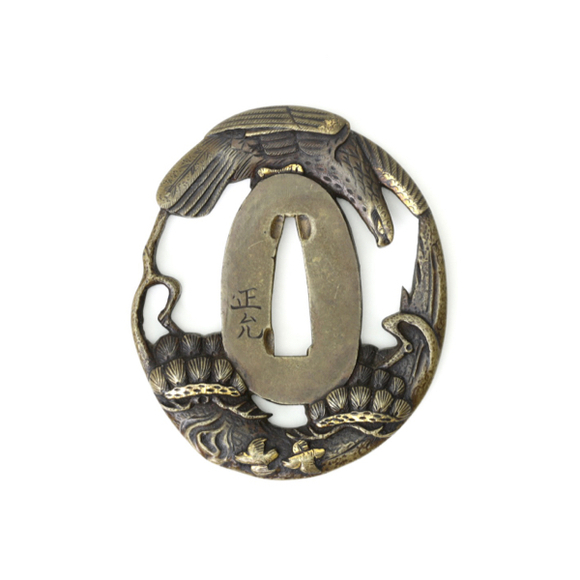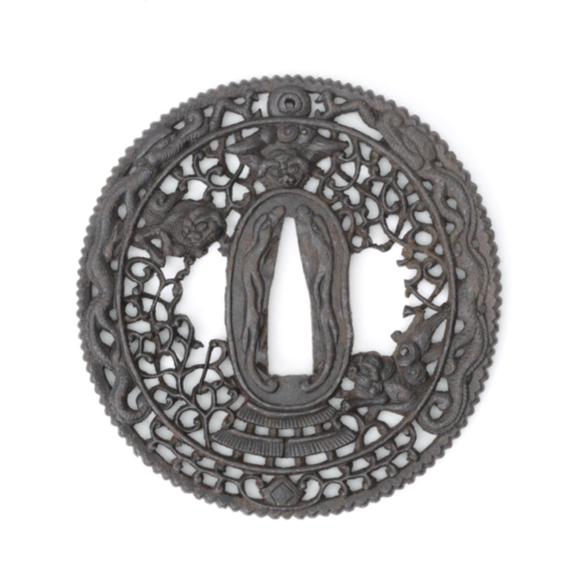Russet iron, one-piece construction with decorative grooves.

In koshirae 104.5 cm
Nagasa (edge length) 69.4 cm
14 mm
Kasane (base) 7.8 mm
Kissaki (tip) 5.1 mm
Blade 728 grams
With hilt 1155 grams
Hilted 14 cm from guard
Blade: Tempered steel
Mountings: Wood, ray-skin, urushi lacquer, brass, shakudō, gold, silk
Blade: Echizen, Japan
Mountings: Edo, Japan
Blade circa 1596-1631
Mountings late 19th century
From a Japanese collection
Introduction
16th century Japan was marked by warfare between several factions that fought for supremacy over Japan. Mino and Bizen were the main production centers for swords in this period, but with the flooding of the Osafune forges in Bizen in 1590, only Mino remained. By the end of the 16th century, power was starting to become consolidated in several castle towns. This caused an exodus of Mino smiths to these new centers of power, among them the San'ami school Kanenori line of smiths.
San'ami Kanenori smiths in Echizen
The San'ami school was founded by a smith who went by the personal name Rokurōzaemon, and who signed Kanenori (兼則). He lived between 1358-1426 and was the son of master smith Kanetomo (兼友), who in turn was the son of Kaneuji (兼氏), one of the best students of Masamune. Kaneuji settled in Shizu in Mino and is widely regarded as the founder of the Mino tradition.
The first San'ami Kanenori to move to Echizen was active around the Chōroku period of 1457-1460. The next was the son of a San'ami Kanenori who moved to Echigo. He is considered the second generation of this particular branch, and was active around the Keichō period of 1596-1615. He apparently traveled with Tokugawa Ieyasu's army, because one of his swords is signed:
越前国兼則関ケ原 御陣作之
Echizen no Kuni Kanenori Sekigahara go-jin kore o saku
"Made by Echizen Kanenori in a field camp at the Battle of Sekigahara”
The Battle of Sekigahara was fought in 1600 and is considered the decisive battle that consolidated Tokugawa rule and hailed in the Edo period.
He was succeeded by the third generation Echizen Kanenori, who was active from around the Kan'ei (1624-1644) to the Kanbun period (1661-1673). He moved out of Echizen before 1631.
Many of the San'ami school Kanenori smiths had wazamono to ryō-wazamono ratings for sharpness.
References
Markus Sesko; Swordsmiths of Japan. Lulu Publishing, 2015. Pages 248-250 and 294-295.
Echizen Kanenori (越前兼則) tachi
The fine tachi-sized blade is unsigned but comes with an NBTHK Hozon attribution to Echizen Kanenori. It is probably the work of the 2nd or 3rd generation Echizen Kanenori.
Blade in a flawlessly forged itame-hada (wood grain) pattern. The hamon is a bright line that consists of sprays of large dimensioned nie crystals that sparkle in the light.

Sword attributes
(With plain English below)
Nakago: Ubu. Mumei. Kurijiri. Kiri yasurime. One mekugi ana.
(Tang: Unaltered. Unsigned. Rounded tip. Straight file marks. One peg hole.)
Sugata: Koshi-zori.. Shinogi-zukuri with noticeable funbari. Iori-mune.
(Overall form: Curvature concentrated at the waist. Blade with ridged sides, ridged spine, and noticeable taper in width. Spine finished with two facets.)
Jigane: A standing out ko itame-hada. Masame in the ji.
(Steel: A markedly contrasting small wood grain with straight grain in the upper facet.)
Hamon: Gunome midare in nie-deki. Some sunagashi.
(Temperline: Undulating hamon with roundish elements. Large martensite crystals demark the tempered zone, some forming lines like flowing sand.
Boshi: Jizō with long kaeri.
(Temperline at tip: Resembling a statue of the Bodhisattva jizō as seen in profile. After it turns back, it runs fairly long along the tip's spine.)

NBTHK Hozon papers
"Unsigned, Echizen Kanenori
Length 2 shaku 2 sun 8 bu"
One thing that stands out for me is that the nakago is finished with straight horizontal file marks. This was a common finish among many Echizen Seki smiths, but the Kanenori line seemed to have stuck with the Yamato tradition hawk's feather (takanoha) finishing with slanted strokes in two directions. NBTHK obviously felt that the workmanship on the blade itself was so representative of Echizen Kanenori that the file marks did not affect the attribution. It could be that the nakago was re-finished at some point.
Itomaki-no-tachi koshirae
The sword comes with a perfectly fitting itomaki-no-tachi koshirae, that appears to be made for this blade. A rarity in a world where almost all koshirae are matched by collectors and dealers in recent times.

Itomaki means "silk wrapped", referring to the grip wrap that continues over the first part of the scabbard. It is believed to have originally been to protect the scabbard from getting damaged by the armor. This style of sword was the regulation pattern sword worn by senior samurai at official court gatherings.
The wooden saya (scabbard) is covered with nashiji (gold-sprinkled lacquer) and mon (family crests) of the Kikkawa clan. Hilt and the upper part of the saya are wrapped with black silk cord over a brown and gold silk brocade background.
The mountings are of shakudō, showing the Kikkawa crests in gold over a fine nanako background. This kind of work is typical for the Gotō family, resident metalworkers for the ruling Tokugawa house.
Itomaki-no-tachi koshirae can be incredibly hard to date because they were made in the same style, using the same techniques, for centuries. The fineness of the metallic particles in the lacquer are one of the few things that may help with dating, as this became finer over time. The set comes with NTHK-NPO papers attributing the koshirae to the Meiji period (1868-1912).

NTHK-NPO appraisal
"Tachi-koshirae featuring saya in gold nashiji lacquer and décor of an arrangement of family crests
Authentic
June 16, 2019
Non-Profit Organization Nihon Tōken Hozon Kai
Board Chairman: Miyano Teiji"
"No 9988
Signature: Unsigned
Measurements: overall length 104.5 cm
Remarks: Hilt covered with brocade and wrapped hishimaki-style with black braid.
Fuchigashira of shakudō with nanako ground, iroe accents, gilded edges, and depicting four-bar crests.
Menuki of shakudō, in katachibori, with iroe accents, depicting iron-ribbed fans and shishi lions.
Tsuba and ō-seppa in aoigata, of shakudō with nanako ground, iroe accents, and depicting four-bar crests.
Sarute, obitori, taikogane, kashiwaba, and kuwagata fittings of same interpretation.
Circa Meiji period (1868‒1912)
Seals of Judges: 5 seals"
It is in near-mint condition, save for some very minor age-related wear a cracked scabbard mouthpiece that was glued back together.

The Kikkawa clan
The Kikkawa were a prominent samurai clan of Fujiwara origins. Kikkawa Motoharu (1530-1586) served as a general of Toyotomi Hideyoshi. The clan ruled over Izumo province. In 1550, the clan name and its domains were annexed by the Mori clan after they had the Kikkawa head assassinated. 1

Kikkawa clan mon on the saya.
If the Meiji period (1868-1912) dating on the koshirae is correct, the sword may be related to Kikkawa Tsunetake (吉川経健), the last of the Kikkawa daimyo. His life spanned from 1855 to 1909. He ruled over the Iwakuni domain. He earned merit in the Boshin war and in 1869 was made Chihanji, equivalent to a position as governor at age 14. The next year, he helped suppress a rebellion in the Choshu domain, ruled by his lord Mori Takachika. In 1871, the Meiji government abolished feudal domains, so he lost his title and moved to Tokyo.2

Tsunetake Kikkawa, personal name Keiken Yoshikawa.
There, he started the Gisaido company that employed former samurai retainers to make them financially independent. They worked as bailiffs and traded paper from his home domain Iwakuni. The company still exists today, trading mainly in textiles.3
He was made a baron in 1884 and viscount in 1891. He passed away in 1909 at age 55.4
The current head of the clan is Japanese singer Koji Kikkowa.
Conclusion
During the Meiji period, samurai were disarmed, but noblemen like Kikkawa Tsunetake were still allowed to wear their swords and this was the style worn during formal court assemblies.
Besides that, fine old blades in itomaki-no-tachi swords still remained appropriate high-level diplomatic gifts. See for example the itomaki-no-tachi presented to the British queen by shōgun Tokugawa Iemochi, or the one presented to the Dutch queen by Emperor Meiji in 1898. Sir Claude MacDonald, the first British ambassador to Japan from 1905 to 1912, also had a fine itomaki-no-tachi that is now in the Victoria & Albert Museum.
It is rare to be able to attribute a koshirae precisely to a historical figure. But the Kikkuwa clan was so small and relatively obscure, that we can safely say this itomaki-no-tachi was probably made for Kikkawa Tsunetake or his father, Kikkawa Tsunemasa, by the Tokugawa court workshops. The blade is a prized older heirloom blade, often found in such mounts.
Notes
1. See the Dutch Royal Collection, accession number MU-5437a. British Royal Collection Trust, namely RCIN 72787. Victoria & Albert Museum accession number M.139:1-1929.






























Unusual tsuba with foreign figures and Chinese auspicious symbols.






